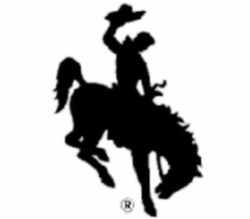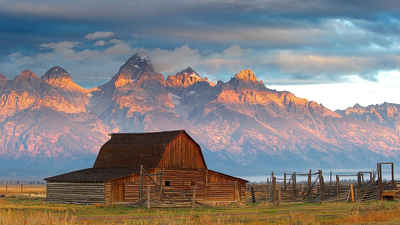Wyoming State Bucking Horse and Rider
The Bucking Horse and Rider

(BH&R)
Adopted 1936
The Bucking Horse and Rider (BH&R) is a federal and state registered trademark of the State of Wyoming from 1936.
The BH&R trademark boasts a rich tradition, for both the State of Wyoming and the University of Wyoming; a tradition which spans nearly one hundred years. This image has become an icon for the entire state and is fast becoming a valuable commercial image in Wyoming and across the United States. People far and wide have come to associate this image with the State of Wyoming and the University of Wyoming.
Wyoming State Bucking Horse
and Rider:
The Bucking Horse and Rider (BH&R)
Because of increasing commercial demands for this trademark, the State of Wyoming and the University of Wyoming have consolidated efforts to protect, preserve and promote the tradition and integrity of the bucking horse and rider trademark on behalf of the entire State. The BH&R is a federally and state registered trademark of the State of Wyoming. A licensing arrangement provides the most efficient and feasible vehicle to ensure that the trademark is protected from misuse or infringement, and that its ownership is rightfully retained by Wyoming, for the people of Wyoming.
Historical Information
The State of Wyoming's first use of the Bucking Horse and Rider (BH&R) mark dates back to 1918, perhaps earlier. The BH&R was used as an
insignia worn by members of the Wyoming National Guard in France and Germany during World War I. The insignia for the uniforms was originally designed
by First Sergeant George N. Ostrom of E Battery, 3rd Battalion, 148th Field Artillery Regiment, AEF. The insignia was officially adopted by the United
States Army and used as a means of identification on gun trails, trucks, helmets and other equipment.
The insignia was then used extensively by Wyoming units during out-of-state and overseas duty, including Korea and Vietnam, and was a rallying point,
a symbol of pride and a reminder of home, the Great State of Wyoming, to our troops.
Some believe that the BH&R is representative of a legendary rodeo horse named "Steamboat" dating back to the early 1900's. One of the
best known bucking horses of all time, Steamboat was known as "the horse that couldn't be ridden." There has been a great deal of dispute
as to the image of the man on the bucking horse.
In 1935, Secretary of State Lester Hunt proposed legislation to make changes to the Wyoming license plate design to combat the problem of wide-spread
counterfeiting of Wyoming's license plate. Therefore, Secretary Hunt (later Governor and United States Senator) commissioned Mr. Allen T. True of Littleton,
Colorado to "put to paper" his concept for a new license plate design which included the famous Bucking Horse and Rider. In 1936, Wyoming's
unique license plates containing the BH&R made their debut.
During that same year, the State obtained a copyright for the mark. Between 1936 and 1995, the BH&R's use by Wyomingites and the State of Wyoming
was continuous and extensive. It is such an important identifier for the State that, in 1990, the Wyoming Centennial Commission used the mark for the
Wyoming Centennial Celebration.
Because of increasing commercial demands for this trademark, the State of Wyoming and the University of Wyoming have consolidated efforts to protect,
preserve and promote the tradition and integrity of the Bucking Horse and Rider trademark on behalf of the entire State. Licensing provides the most
efficient and feasible vehicle to ensure that the trademark is protected from misuse or infringement, and that ownership is rightfully retained by
Wyoming, for the people of Wyoming.
Wyoming Law
The law designating the "Bucking Horse and Rider" as the official Wyoming state trademarks is found in the Wyoming Statutes, Title 8, Chapter 3, Section 8-3-117.
Title 8 General Provisions
Chapter 3 State Seal, Flag, Flower, Bird and Other Symbols
Wyo. Stat. § 8-3-117 (2013)
§ 8-3-117. "Bucking Horse and Rider" and related trademarks.
(a) The secretary of state shall promulgate rules regulating the licensing or other authorized use of the "Bucking Horse and Rider" and related
trademarks.
(b) Any licensing fees, royalties or other revenues collected by the secretary of state under this section shall be deposited into a separate account.
The legislature shall by appropriation authorize expenditures from the account as necessary to defray administrative expenses associated with licensing
of the trademark and expenditures required to protect, preserve and promote the "Bucking Horse and Rider" and related trademarks on behalf
of the state.
HISTORY: Laws 1998, ch. 101, § 1; 2005, ch. 231, § 1.
NOTES:
The 2005 amendment, effective July 1, 2005, in (b), substituted "into a separate account" for "into an account within the enterprise
fund."
Conflicting legislation. --
Laws 2005, ch. 231, § 3, provides: "The provisions of this act shall supersede the provisions of any other bill enacted into law during the
2005 general session which amends or references accounts or funds to the extent any other enactment is inconsistent with the establishment of the funds
and accounts created under this act. The state auditor shall account for any fund or account created in any other legislation enacted in the 2005 general
session in accordance with generally accepted accounting principles (GAAP) as promulgated by the governmental accounting standards board (GASB) and
in accordance with this act."








